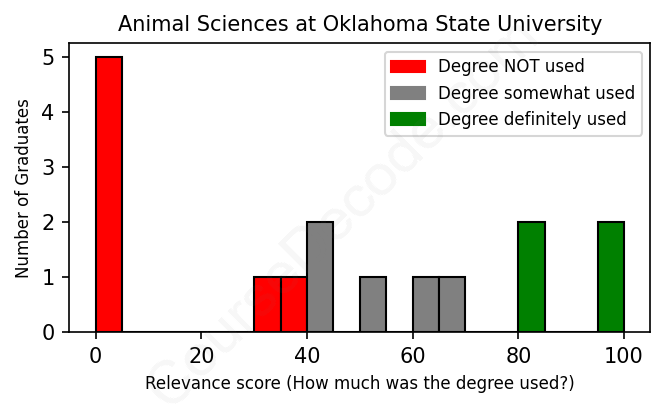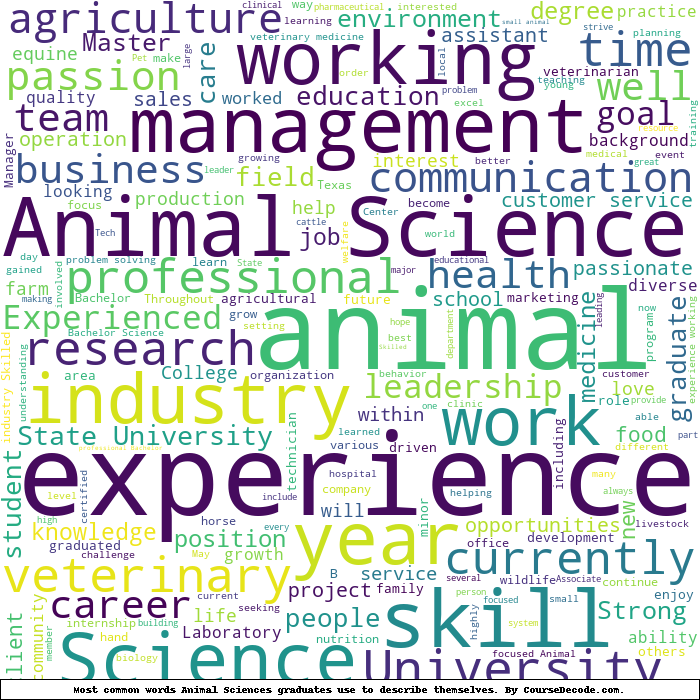
First, some facts. Of the Animal Sciences graduates from Oklahoma State University we've analyzed , here's how many have used (or NOT used) their degree in their career:

These are estimates based on AI analysis of 16 LinkedIn profiles (see below).
The verdict? Bad. Overall, with an average relevance score of 43%, Animal Sciences graduates from Oklahoma State University have a substantially lower likelihood (-24%) of finding work in this field compared to the average graduate across all fields:
And for comparison, here's the chart for all profiles we've looked at across all degrees.
Also, after graduating, 37% of these graduates have pursued further education other than another Bachelor's degree (such as a Masters degree or other), compared to the average across all profiles of 35%. This suggests you may need more than just a Bachelors degree to be competitive as a Animal Sciences graduate.
See the details:
|
Relevance score: 0% We think this person has NOT gone into a career related to their degree. We think this person has NOT gone into a career related to their degree.
DEGREE INFOGraduated in 2020 from Oklahoma State University with a Bachelor of Science - BS in Animal Sciences. Also pursued further education since (see below). JOB HISTORY SINCE GRADUATIONSummer Intern Texas A&M Federal Relations Office May 2023 - Aug 2023 FURTHER DEGREES DONE SINCE GRADUATINGMaster of Science - MSTexas A&M University 2020 - 2022 ABOUTNo information provided. |
The top 10 most common jobs done by the graduates we've analyzed (ranked most common to least) are:
It looks like there’s quite a mix when it comes to the jobs people with Animal Sciences degrees from Oklahoma State University are landing. A lot of grads seem to end up in roles that are pretty relevant to their studies, like Ranch Manager, Veterinary Technician, or even working as Agricultural Extension Agents. These positions make good use of the knowledge they gained from their degree, whether it’s about animal care, nutrition, or even research. For instance, working at a veterinary hospital or as a Dairy Sustainability Manager are perfect matches that help students apply what they've learned about animal health and sustainable practices in real-world settings.
On the other hand, many others take paths that have little to do with Animal Sciences. Jobs like Sales Associates or positions in marketing seem to pop up frequently, which mostly rely on customer service or sales skills rather than animal-related expertise. While these careers may involve some indirect referencing of their degree—like understanding agricultural products or animal behavior for a marketing role—most don’t tap into the specialized knowledge that the Animal Sciences degree offers. Overall, it seems like while there are definitely solid career paths aligned with Animal Sciences, there's a fair share of graduates who end up in unrelated fields, highlighting the versatility (or ambiguity) of the degree in the job market. If you're passionate about animals, though, there are plenty of options out there that will let you engage with that passion directly!
Here is a visual representation of the most common words in job titles for Animal Sciences graduates (this is across all Animal Sciences graduates we've analyzed, not just those who went to Oklahoma State University):

Based on the LinkedIn profiles of graduates from Oklahoma State University's Animal Sciences program, it looks like these individuals have taken a variety of career paths after graduation, with mixed success in staying within the realm of animal sciences. For many of the graduates, the first job tends to be either in management positions related to ranches or agricultural settings, or in specialized roles like veterinary technicians. For example, a graduate from 2016 works as a neurology veterinary technician, showing a clear path aligned with animal health. However, several graduates, particularly those from more recent years, have ventured into unrelated fields like sales, marketing, and even banking. This suggests that while some students do find jobs closely related to their degree, others seem to drift away from animal sciences quite quickly after entering the job market.
Looking further down the line, such as five to ten years post-graduation, we see that those who stayed within the animal sciences field tended to secure more specialized roles, such as sustainability managers or veterinary technicians. However, numerous individuals shifted gears altogether into business, sales, and marketing roles, which while not directly related to their studies, still demonstrate their adaptability in various industries. This trend indicates that while a degree in animal sciences provides a foundational knowledge and skills base, the career trajectories can vary greatly, and many graduates may not end up directly in animal-related careers. So, if you’re considering this path, it’s good to keep an open mind about where your degree might take you!
Hey there! So, a Bachelor’s degree in Animal Sciences, whether at Oklahoma State University or somewhere else, can be a mix of both challenging and manageable, depending on your interests and strengths. You'll dive into some serious science topics like biology, physiology, and nutrition, which can get pretty intense if you're not super passionate about it. There’s also a good amount of hands-on experience, which many students love, but it can be a bit demanding at times. If you have a genuine love for animals and a knack for science, you might find it easier than average, but it can definitely be hard work for others. Just remember, staying organized and keeping up with your studies goes a long way in making it a great experience!
Most commonly, in the LinkedIn profiles we've looked at, it takes people 2 years to finish a Bachelor degree in Animal Sciences.
So, looking at this bunch of Animal Sciences grads from Oklahoma State, it seems like they’re finding some decent gigs, but the money might be all over the place. Some of them, like the ones in managerial or specialized roles, seem to be doing pretty well—especially those who are working as Product Marketing Specialists or running their own consulting businesses. On the flip side, there are folks starting off as sales associates or general laborers who probably aren’t banking huge bucks just yet. Overall, it looks like it varies a lot—some are on a solid path to good earnings, while others are still figuring things out. As with many fields, experience and specialization can really make a difference in income down the line!
Here is a visual representation of the most common words seen in the "about" section of LinkedIn profiles who have a Bachelor degree in Animal Sciences (this is across all Animal Sciences graduates we've analyzed, not just those who went to Oklahoma State University). This may or may not be useful:

Here are all colleges offering a Bachelor degree in Animal Sciences (ordered by the average relevance score of their Animal Sciences graduates, best to worst) where we have analyzed at least 10 of their graduates:
| College | Score | Count |
|---|---|---|
 Purdue University Purdue University
|
80 | 14 |
 California State Polytechnic University-Pomona California State Polytechnic University-Pomona
|
78 | 13 |
 North Carolina State University North Carolina State University
|
77 | 18 |
 Iowa State University Iowa State University
|
75 | 25 |
 University of Missouri-Columbia University of Missouri-Columbia
|
75 | 12 |
 South Dakota State University South Dakota State University
|
73 | 10 |
 The Ohio State University The Ohio State University
|
71 | 21 |
 University of Florida University of Florida
|
68 | 15 |
 University of Vermont University of Vermont
|
68 | 12 |
 Michigan State University Michigan State University
|
67 | 20 |
 University of California, Davis University of California, Davis
|
66 | 27 |
 University of Illinois at Urbana-Champaign University of Illinois at Urbana-Champaign
|
63 | 16 |
 University of Tennessee, Knoxville University of Tennessee, Knoxville
|
61 | 13 |
 University of Arkansas University of Arkansas
|
60 | 10 |
 California Polytechnic State University-San Luis Obispo California Polytechnic State University-San Luis Obispo
|
59 | 22 |
 University of Wisconsin-River Falls University of Wisconsin-River Falls
|
58 | 10 |
 Texas A&M University Texas A&M University
|
54 | 34 |
 Penn State University Penn State University
|
53 | 14 |
 Texas Tech University Texas Tech University
|
51 | 12 |
 Kansas State University Kansas State University
|
51 | 22 |
 Oklahoma State University Oklahoma State University
|
43 | 16 |